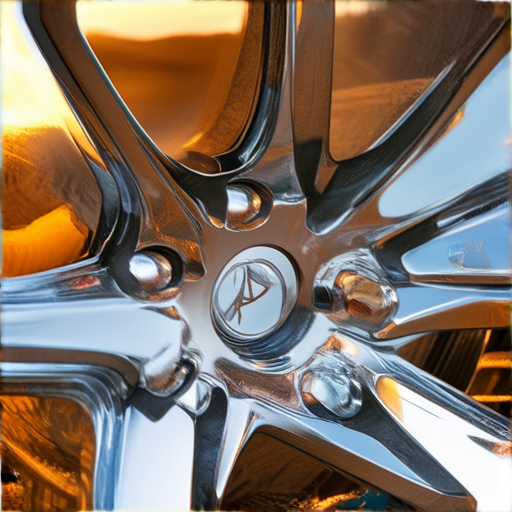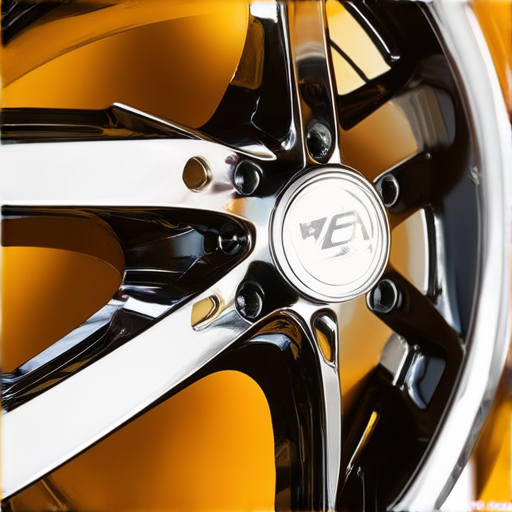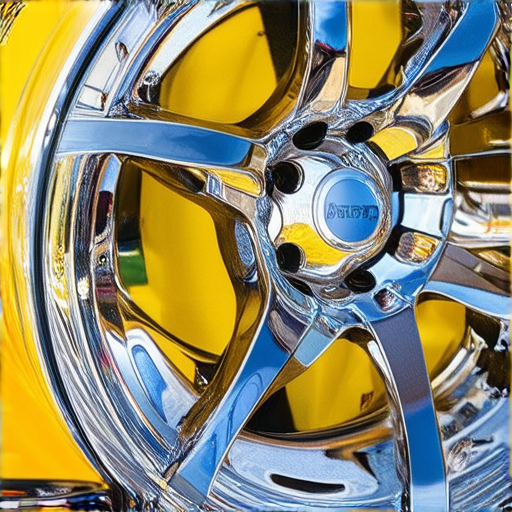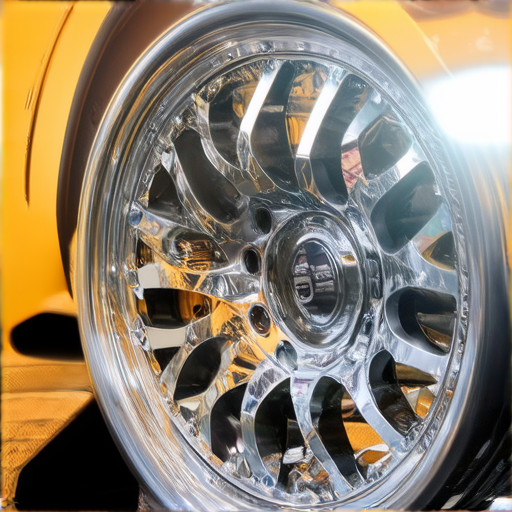When it comes to enhancing the appearance of your vehicle, one crucial aspect that often gets overlooked is the condition of your car’s wheels. A well-maintained set of wheels can significantly elevate the overall aesthetic appeal of your ride, making it stand out from the crowd. However, achieving a mirror-like finish requires more than just a quick wipe-down with a cloth – it demands a thoughtful approach that involves selecting the right cleaning products, preparing the surface correctly, and applying the perfect amount of polish.

Polishing Alloy Wheels to Mirror Finish
To achieve a mirror-like shine on your alloy wheels, you’ll need the right tools and techniques.
- Choose the Right Polishing Compound: Select a high-quality polishing compound specifically designed for aluminum wheels. Some popular options include Meguiar’s Ultimate Compound and Chemical Guys Wheel Cleaner.
- Select the Correct Buffer: Use a dual-action buffer or a rotary buffer with a soft foam pad to prevent scratching the wheel surface.
- Prepare the Surface: Clean the wheel thoroughly with soap and water, then dry it with a microfiber towel. Remove any brake dust or debris using a brush or a specialized cleaning tool.
- Apply the Polishing Compound: Dab a small amount of polishing compound onto the wheel surface, working in a circular motion. Make sure to cover the entire area evenly.
- Buff the Wheel: Using a slow to medium speed setting, begin buffing the wheel in a circular motion. Gradually increase the speed as needed, but avoid applying too much pressure, which can cause scratches.
- Inspect and Repeat: Regularly inspect the wheel for any remaining imperfections or discoloration. Continue buffing until the desired mirror-like finish is achieved.
- Final Touches: Once you’ve achieved the desired level of shine, apply a protective coating to seal the wheel and protect it from future damage.
Remember to work patiently and carefully, as excessive pressure or aggressive buffing can lead to scratches or damage to the wheel.
Tips and Precautions:
- Always read the manufacturer’s instructions for the polishing compound and buffer you’re using.
- Wear protective gloves and safety glasses to prevent injury from flying particles or chemical splashes.
- Avoid using harsh chemicals or abrasive materials, which can damage the wheel or surrounding components.
- Regularly clean and maintain your wheels to prevent brake dust buildup and maintain their appearance.
Additional Resources:
For more information on polishing and caring for your alloy wheels, visit our dedicated resource page at Alloy Wheel Care.
How to Make Car Wheels Shine
To achieve a showroom shine on your car’s wheels, you’ll need the right cleaning products and techniques.
- Cleaning Products: Use a mild soap solution or a dedicated tire cleaner to remove dirt and grime. Avoid using household cleaners or strong chemicals, which can damage the wheel’s finish.
- Tire Brush: A soft-bristled brush is ideal for gently scrubbing away tough stains and debris.
- Dry Cloth: After cleaning, use a dry cloth to wipe down the wheel and remove any excess moisture.
- Wheel Wax: Apply a small amount of wheel wax to protect the finish and give it a glossy sheen.
Step-by-Step Instructions
- Start by washing the wheel with a mild soap solution to remove loose dirt and debris.
- Use a soft-bristled brush to gently scrub away any stubborn stains or grime.
- Rinse the wheel thoroughly with water to remove any soap residue.
- Use a dry cloth to wipe down the wheel and remove any excess moisture.
- Apply a small amount of wheel wax to protect the finish and give it a glossy sheen.
Tips and Tricks
- Regular Cleaning: Clean your wheels regularly to prevent dirt and grime from building up.
- Avoid Harsh Chemicals: Never use harsh chemicals or abrasive materials to clean your wheels, as they can damage the finish.
- Protective Coating: Consider applying a protective coating to your wheels to shield them from the elements and extend their lifespan.
Recommended Products

Does WD40 Clean Alloy Wheels?
We’ve received numerous questions regarding the effectiveness of WD40 in cleaning alloy wheels.
- WD40 is a penetrating oil that can dissolve and loosen dirt, grime, and other substances
- Its ability to cut through tough residue makes it a popular choice for cleaning various surfaces
- However, its suitability for cleaning alloy wheels depends on several factors
Why WD40 Might Not Be the Best Choice:
While WD40 can effectively clean certain types of surfaces, it may not be the most suitable option for alloy wheels due to its chemical composition.
- WD40 contains petroleum-based solvents, which can potentially damage certain types of paint or coatings
- Additionally, its high viscosity can leave behind streaks and residue, potentially attracting dirt and dust
- For these reasons, it’s essential to exercise caution when considering WD40 for cleaning alloy wheels
A Better Alternative:
Instead of relying on WD40, consider using a dedicated wheel cleaner specifically designed for alloy wheels.
- These cleaners typically contain gentle yet effective ingredients that won’t damage the wheel’s surface
- They’re often pH-balanced to prevent etching or discoloration
- Look for products containing mild abrasives or solvents that won’t harm the wheel’s finish
Best Practices for Cleaning Alloy Wheels:
To keep your alloy wheels looking their best, follow these tips:
- Regularly wash the wheels with a soft-bristled brush and mild soap solution
- Dry the wheels thoroughly to prevent water spots
- Apply a protective coating or sealant to shield the wheels from the elements
Conclusion:
In conclusion, while WD40 might seem like a convenient option for cleaning alloy wheels, its potential drawbacks make it less desirable.
By choosing a dedicated wheel cleaner and following best practices, you’ll be able to keep your alloy wheels looking their best and maintain their longevity.

Polishing Scratches Out of a Wheel
At Incubus Wheels, we understand the frustration of dealing with scratched or scuffed wheels.
-
Fortunately, minor scratches and scuffs can often be repaired through a process called polishing or refinishing.
-
A professional can buff out the scratches and apply a new finish to restore the wheel’s appearance.
Assessing the Damage
To determine whether your wheel can be polished, inspect the scratch or scuff carefully.
-
Check the depth and length of the scratch or scuff.
-
Determine the type of material the wheel is made of.
-
Consider the color and finish of the wheel.
Choosing the Right Polishing Method
There are several methods for polishing scratches out of a wheel, including:
-
Ceramic polishing compounds
-
Polishing kits specifically designed for wheels
-
Professional-grade polishing machines
DIY vs. Professional Repair
While DIY polishing kits can be effective, a professional repair may be necessary for deeper scratches or more extensive damage.
We recommend consulting a trusted mechanic or auto body specialist for a thorough assessment and repair.
Maintaining Your Wheels
To prevent future scratches and scuffs, consider the following tips:
-
Regularly wash and dry your wheels
-
Apply a protective coating to your wheels
-
Park your vehicle in a shaded area to reduce exposure to UV rays
Additional Resources
For more information on wheel maintenance and repair, visit our wheel maintenance tips page.
Learn more about our custom wheel design services and how we can help you achieve the perfect look for your vehicle.
Discover the benefits of automotive performance enhancements and how they can improve your driving experience.
Does Magic Eraser Remove Car Scratches?
As a car enthusiast, I’ve often wondered whether Magic Eraser can effectively remove car scratches.
- Magic Eraser is made of melamine foam, which has an extremely fine sandpaper-like texture
- This abrasive quality makes it suitable for removing scuffs and marks from various surfaces
- However, its potential to damage the clear coat or paint if used improperly raises concerns
Risks Associated with Using Magic Eraser on Cars
The primary concern with using Magic Eraser on cars is the risk of damaging the clear coat or paint.
- Incorrect usage can lead to scratches, swirl marks, or even paint removal
- The abrasive nature of Magic Eraser may not be gentle enough for delicate car surfaces
- It’s essential to exercise caution and consider alternative methods for removing car scratches
Alternatives to Magic Eraser for Removing Car Scratches
If you’re unsure about using Magic Eraser on your car, there are alternative methods worth considering:
- Ceramic scratch removers: These products are specifically designed for car surfaces and offer a gentler approach
- Polishing compounds: These can help restore the shine and smoothness of your car’s surface
- Professional detailing services: If the scratch is severe, consider consulting a professional detailer for assistance
Precautions to Take When Using Magic Eraser on Cars
If you still want to try using Magic Eraser on your car, take these precautions:
- Test a small, inconspicuous area first to gauge the effectiveness and safety
- Apply gentle pressure and work in a circular motion
- Avoid using Magic Eraser on sensitive areas, such as trim or moldings
Conclusion
In conclusion, while Magic Eraser can be effective for removing scuffs and marks, its potential risks associated with car surfaces make it essential to exercise caution.
Consider alternative methods or consult a professional detailer for assistance to ensure the best possible outcome for your car’s appearance.

How to Make Your Scratched Rims Look Better
To restore your scratched rims to their original shine, start by cleaning the affected area thoroughly with a mild soap solution and a soft-bristled brush.
-
Next, apply a rim repair kit specifically designed for removing scratches and swirl marks. These kits usually come with a polishing compound and a applicator pad.
-
Gently rub the polishing compound onto the scratch using a circular motion, working from the center of the rim outwards.
-
Continue applying pressure and rubbing until the scratch begins to fade, then switch to a clean, microfiber cloth to wipe away any excess polish.
-
For deeper scratches, consider using a rim refinishing kit, which typically includes a sanding block and a specialized coating to fill in the scratch.
-
Once you’ve removed the scratch, apply a coat of clear wax or sealant to protect the rim and give it a glossy finish.
Tips and Tricks:
-
Always read the instructions carefully before applying any chemicals or products to your rims.
-
Test a small, inconspicuous area first to ensure the product doesn’t damage the rim’s finish.
-
Work in a well-ventilated area, and avoid applying products in direct sunlight or extreme temperatures.
-
Regular maintenance, such as washing and drying your rims regularly, can help prevent scratches and keep them looking their best.
Additional Resources:
For more information on restoring your scratched rims, check out our guide on Rim Repair Kit Reviews and learn how to choose the right products for your needs.
You can also visit our Custom Wheel Design Trends page to stay up-to-date on the latest styles and techniques in the industry.
Remember to always follow safety precautions and manufacturer instructions when working with chemicals and power tools.

0 Comments